The English language is filled with words to express a feeling or emotion through a color: “green with envy”, “feeling blue”, “seeing red”, “a yellow coward”, etc. But do such words and phrases have equal signficance to the color blind who perceive the world differently? Yuasa Noriko’s short movie Coming Back Sunny is a movie about adolescence and the maelstrom of emotions that come with high school life. Shiori, the protagonist, is unable to perceive red and green. To her these colors seem the same umber color. Then one day, she sees a flash of red in a colorless petal picked up by her friend Yumi. Thus begins Shiori’s plunge into newfound experiences of her world and those around her.
The story is an elegantly styled allegory for a teenage girl’s awakening emotions as it changes her relations with people (and vice-versa); her color-blindness only serves to enchance the wonder and confusion she experiences. The first time the phenomenon occurs, she describes it through onomatopoetic words often used in Japanese: “whoosh, boom, OMG”. It’s not a coicidence those same Japenese words can be used to express the kind of swooning someone may feel when they first fall in love or become attracted to someone. The fact this happens when her friend Yumi touches the petal is of particular importance. But as she begins to see red everywhere, Shiori becomes confused. The situation is not helped by an apparent “betrayal” by her friend, and an encounter with a high school boy who claims they are a destined couple; here the term “blush” being used. Ultimately, Shiori’s bewilderment becomes the impetus for exploring her burgeoning sexual identity and the choices ahead for her.
Taking advantage of a RED cinema camera, Yuasa portrays a bright colorful world around Shiori to emphasize the circumstance of her color-blind protagonist . More importantly, Yuasa skillfully employs editing to paint particular emotional states– drops of water color paint into clear water have both a symbolic significance when cut between scenes such as the moment Shiori becomes angry at Yumi or the opening sequence of dancing, energetic teens; and literal significance as these seem to be the paints being used by a boy Shiori encounters. A skillful storyteller in various mediums and formats, Yuasa displays a confident hand in how she wants this adolescent love story to unfold. If there is only one drawback, the 15 minute runtime only hints at some something more as seen in Yumi’s determined look at the close of the movie. What has been presented would make a fine presentation reel to raise funds for an episodic or feature. Yuasa herself commented on her Instagram (linked here): “This film is my own ‘Romeo and Juliet’. And it is not finished yet, and the story ends just before it reaches its peak.” Fingers crossed she can develop this story to its full potential. An Audience Award win at the ARFF Paris certainly shows there is an (ahem) audience for it. The Firenze Film Corti Festival also just recently announced Coming Back Sunny is a selection finalist for their upcoming 7th edition, though with the coronavirus pandemic, dates are still up in the air.
Meanwhile, Yuasa is developing a feature project from her original screenplay. Currently the project, tentatively titled Performing Kaoru’s Funeral, has begun seeking financing with an American producer which came about through her participation at the American Film Market in 2019. The movie is described as a “heavy comedy . . . packed with immense irony and love” that will “[depict] the last moments of a woman’s life.” More on this as information is released.
